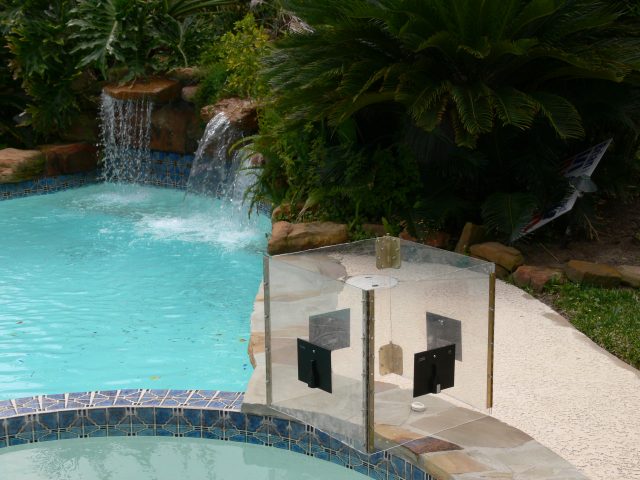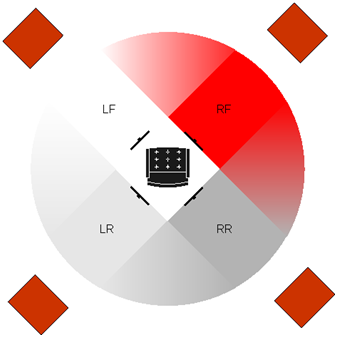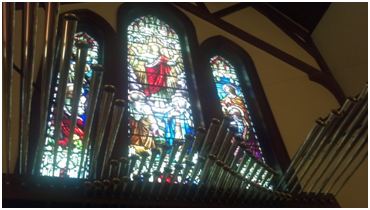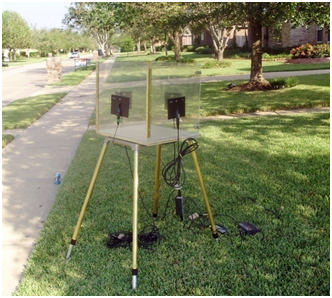
- SoundCube recording an immersive soundfield. If you play this recording back correctly, you will hear what you would hear if you were sitting where the device is.
Prolog
The CD killed “high fidelity.” Before turning away in disgust, read a little more. The advent of 4 channel sound in the 70s was pretty awful. The master recordings could be pretty good, but there was no way to reproduce them properly at home. The results were extremely disappointing. However, so were the first mechanical recordings. The first electrically produced recordings were, in turn, described as “remote” and “unnatural” compared to their mechanical predecessors. The first LPs were considered “lofi” compared to 78s. Audiophiles shunned the initial stereo release as “gimmicky” and not true to the music. However, all these innovations were finally refined and accepted.
Except for surround. Quad was at its most confusing and worst in the early 1980s when the CD exploded onto the scene with and easy way to “perfect sound forever” requiring nothing but a single standard player. Quad had 6 different systems, all except for 4 track reel to reel with serious drawbacks, both sonic and technical. The CD used the proven 2 channel recording techniques and a standard device. This technology was incredibly advanced and on the bleeding edge of the possible. A 4 channel version was feasible, but it would only have held 30 minutes of music. That’s less than an LP of the time and nobody in the audio business was going to go there, plus they had already had enough. They were in the business to make money, not advance high fidelity. Within a few years, quad was a bitter memory in the minds of the music industry and the public as well.
Let me state this clearly and categorically:
Nothing that follows should be construed as suggesting that satisfying musical experiences cannot be obtained by other methods. Proof this is not the case resides in my own listening library. David Hafler obtained a degree of Virtual Presence over 40 years ago in his DynaQuad sampler LP, though the effect was quite localized to a “sweet spot” and variable over the disk. Others have succeeded to some degree or the other using various approaches. However, other methodology relies on decades of experience, luck, good karma, and a variety of other things one may or may not have access to or possess. For the beginner, or the experienced audio engineer wishing to simply “capture the moment,” the Six Cardinal Rules offer a methodology that guarantees a recording with Virtual Presence. Also, note that if you use microphones other than the PZMs, you must have an in-depth understanding of their pickup patterns and interactions with each other in order to approximate or match the 360° pickup of the SoundCube. The same caveats go for variances in speaker type and placement.
Virtual Presence
“Virtual Presence” is the term I use for the process of providing the human brain with precisely the information required to recreate the original soundfield. Today, highly complex and sophisticated circuitry attempts to, and in many cases, succeeds in, creating an involving, immersive, and sometimes even relatively accurate soundfield. However, many times it also fails, and fails miserably. Experience suggests that the reason for this is that modern circuitry, even at its best, is no match for the human brain. You just can’t fool Mother Nature.
Those older audiophiles who remember or heard about the “quad” debacle of the 70s, and those younger ones who’ve heard nothing but the generally ghastly more current attempts at “surround” sound and are absolutely convinced that stereo is the best we can hope for please note this logic:
IF STEREO WORKS, DOUBLE STEREO TO PROVIDE THE REAR INFORMATION MUST WORK ALSO.
Yes, shouting. It’s necessary as the bias towards any advances in audio recording are so ingrained as to have ended real progress towards high fidelity decades ago. Please read the following with open mind and ears.
Six Cardinal Rules of Sound Acquisition
It was a visit to the laboratory of the late “Legend in Sound” Paul W. Klipsch in the early 1970’s that ignited my quest for Virtual Presence. For that reason, I don’t believe he will begrudge using his “Cardinal Rules” descriptor to attempt to describe for acquisition what he did for reproduction.
- Conventional “Stereo” is simply dual channel mono and is incapable of delivering Virtual Presence.
- To achieve “Virtual Presence,” 4 identical microphones must cover 360° with seamless overlap.
- Mixing = editorializing, no matter how well it is done and inhibits the achievement of Virtual Presence.
- The simplest possible signal path from microphone to storage must be used.
- There must be a minimum delta from master to distribution copy and the ideal is none.
- Reproductive conditions must be as close as possible to the inverse of acquisition.
1. Conventional “Stereo” is simply dual channel mono and is incapable of delivering Virtual Presence.
In recent years, home theatre systems with their 5 or more channels have rapidly become ubiquitous. This has produced renewed interest in surround audio. Many in the audio world eschew anything beyond stereo as unnecessary and gimmicky. On the other hand, we heard exactly the same thing from their fathers and grandfathers when stereo debuted. Both they and their fathers/grandfathers were correct. Early stereo WAS gimmicky and full of “Hey! Listen to this ‘Ping-Pong’ effect.”
In fact, it is not possible to record certain events with any degree of reality in only 2 channels. I have rarely ever used more than two microphones for stereo, and the most often asked question in the field was always “Why only two microphones?” My stock answer was always the same: “I have only two ears!” That answer was, and remains true, for simple 2-channel stereo. However, it does not apply to “Virtual Presence” where 4 microphones are the required. The reason that 2 microphones cannot provide a realistic soundfield when 2 ears can is simple: no brain. In the 1970’s, attempts were made to fix this with what amounted to “artificial brains.” The first, simplest, and possibly the best was David Hafler’s “DynaQuad” system, which used passive circuitry (unnecessary to get into the theory here) to extract out-of-phase information from normal stereo recording and route it to the rear. At its best, the impact was marvelous, and I have Hafler circuitry in my stereo even today as it adds much to stereo sources. However, there is a fundamental flaw in this approach when re-creating a “Virtual Presence” as true to the original soundfield as possible: it is in no way comparable to the natural “Hafler circuitry” built into our brains. The point is this: Give your brain the data points it needs and let it do the work.
2. To achieve “virtual presence,” 4 identical microphones must cover 360°
By placing 4 microphones in the “best seat in the house” you provide the brain with the data points it needs to triangulate the origination point of every sound in the acoustic space-time event. In order to test this concept, I developed the MBS SoundCube. The SoundCube is based on the Crown PZM (Pressure Zone Microphone) microphone. The PZM is the only microphone design aside from the ribbon and the omnidirectional to have a “natural” pickup pattern. While many different microphones have been developed with a wide variety of pickup patterns, all of them rely on phase cancellation to achieve the desired performance. While effective for news people, moviemakers, and the NSA, they are not the best choice for Virtual Presence. Of the 3 “natural” pickup patterns, I have experimented with ribbon microphones (figure of 8 pickup pattern) and the PZM (semi-circular pattern). The SoundCube is the result of my experiments with the PZM, and the easiest to use in this explanation of Virtual Presence.
The diagram at the left shows the natural 180° pickup pattern of the PZM. Omni’s and ribbon mikes pickup sound reflected from the walls, floors, and other objects in a room. For stereo, and with the mikes properly positioned, this doesn’t impact the recording too much. However, these out of phase signals confuse the extremely sensitive direction finding capabilities of the human brain. Further, it is extremely difficult to perfectly overlap conventional microphones such that the areas covered by each mike overlap perfectly. If the overlap is imperfect, the human brain will interpret this as spurious directional information. Considerable experience and knowledge is required to apply either omnis or ribbons to 4 channel use.
Enter the PZM and SoundCube. Each square has a hole in the center for mounting a PZM microphone with a butterfly nut. This arrangement provides all the data points required by the human brain to recreate Virtual Presence with 4-180° zones with a 90° transition zone yielding the requisite seamless coverage.
Nothing in the above should be taken to suggest that only PZM microphones are capable of achieving Virtual Presence. I have achieved Virtual Presence with ribbon microphones, which are my personal favorite microphones for acoustic instruments and natural sounds. All audio engineers have their bias and preferences in microphones, and despite my personal dislike of phase-based directional microphones, it is possible to achieve virtual presence with them if they are properly deployed in accordance their design specifications and the above principles. However, the use of PZMs in the SoundCube configuration reduces the highly complex task of microphone configuration and placement to that of simply locating the “best seat in the house” and placing the SoundCube there as a proxy for the listener.
3. Mixing=editorializing, no matter how well it is done and prevents the achievement of Virtual Presence.
Let me be clear: Mixers are a good thing. There would be no Dark Side of the Moon or thousands of other great audio experiences without them. But those are not recordings of acoustic space/time events and only become so when played back on the target system they were designed for. However, in the quest for Virtual Presence, they have no place. For one thing, they violate one of the cardinal rules, that dealing with the simplest signal path being the best, but most importantly, they represent editorializing. What it means is that the audio engineer does not believe it possible to deliver a quality recording without tampering with the soundfield. In my case if confronted with such a situation I just walk away. If there is no “best seat in the house” then I really can’t expect to enjoy the performance. So why would I want to preserve it.
4. The simplest possible signal path from microphone to storage must be used.
The mantra of many audiophiles is “The perfect preamplifier is a straight wire with gain.” While this goal is, at present, unattainable, the criterion it represents is something all recording engineers should strive for. Modern audio processing circuitry is frightfully good, but every issue it seeks to address in the acquisition of acoustic music in fine environments can be eliminated by following the rules as stated so far. Therefore, only the essential paths should be followed: microphone to preamp, preamp to Analog to Digital (A-D) converter, thence to storage. Even modest microphones, preamps, and A-D converters used within this framework can provide a more satisfying Virtual Presence than 6 figures worth of gear passing through endless processes, mixing, and conversion.
Now, all you have to do is deliver it.
5. There must be a minimum delta from master to distribution copy and the ideal is none.
At this point, we run into a bit of a problem. To date, every MBS recording has been a master. That is, recorded either at the 16/44.1 resolution of CD to begin with or at exactly twice that rate so that reduction to Redbook is divisible by two. Since no mixing, processing, or any other alterations of the original file takes place, each CD was identical to the original master. This is how it should be, and as such, exceeds even the legendary “direct to disk” LP’s of old in that the analog disk reproduction processes made delivery of a master to the end user impossible.
However, Virtual Presence requires 4 channels and a delivery medium. The ideal method would be to deliver the files as raw data but few listeners have either the skills or the equipment to replay these. I’ve experimented with a number of formats, but have remained with PCM largely for reasons of cost. Since I make no money from this I don’t have much to spend on it. My current recorder is the Roland-R44E 4 channel device.
As to delivery medium, as of this writing I am still playing back directly from the Roland. However, I have also succeeded in creating a 4 channel interleaved FLAC file. I understand that the OPPO BDP series players can handle these directly from a USB drive, as well as VLC Media Player and JRiver on the PC. At this time I am re-configuring a room for my Virtual Presence experiments and hope to be able to provide a complete “how to” guide for easy playback, as well as examples, in the not too distant future.
6. Reproductive conditions must be as close as possible to the inverse of acquisition.

With four identical speakers spaced at equal distances, your head should hear “virtually” what SoundCube did.
The ideal playback is as close to the inverse of the original 4 microphones. That is, four identical speakers equidistant from the listening point. If the principles have been followed so far, then a person sitting dead center in this array should have an uncanny sense of “Virtual Presence.” They are now positioned as if they had been at the original event sitting in the center of the SoundCube. The outer square represents the SoundCube, with the loudspeakers in the same position as the PZMs.
One thing that SHOULD be obvious but which I learned from experience was that a lounger or any object must not interfere with the rear channels or the illusion is significantly impacted. As in a concert venue, you need seating that ensures that the sound from the rears arrives as directly as that from the front pair. I have some theories about the best height for speakers in a Virtual Presence setup I will experiment with when the basics are complete.
Does it work? I did some test recordings with the SoundCube on my front porch about a decade ago right after constructing the first SoundCube. During the recording, I went outside to check on something or the other and as I went out, the wind caught the front door and slammed it pretty hard. When I played the recording back on 4 identical Frazier Mark IV loudspeakers, the environment was very convincing and involving. The speakers were positioned precisely mimicking the position of SoundCube outside. Then the door slammed. I immediately jerked around and looked towards the door to see who had come in, as my brain was completely fooled and I fully expected to see someone entering the room. I did not realize what had really happened until I got up and verified that no one was present. I repeated this with several other people, and all behaved exactly as I did. I got a lot of laughs from this. More importantly, it proved the point: Realistic reproduction must be the inverse of the source recording and Virtual Presence IS possible. A few years later I made a recording from the street position in front of my Seabrook home using the setup as shown in one of the photos above. A helicopter flew over during the recording. My daughter was in the listening room when I played it back, and when the helicopter flew over she LOOKED UP at the ceiling!
CONCLUSION

Antiphonal organ on church rear wall. This sound should come from behind the listener just as in the real world. If it doesn’t, it may sound great but cannot be called “high fidelity.”
Consider the pipe organ. The space housing the instrument is very much a part of it. A pipe organ sitting out in the open would not sound very good at all, nor does a fine instrument housed in a poor space. The amount and manner of the return reverberation of the sound is very much a part of the overall experience. Four microphones producing 4 discrete channels of information from a single point, preferably the best seat in the house, are required to approximate the experience. This is even more important for antiphonal instruments or bombarde divisions. It is very strange to hear bombarde division emanating from the front! Of course, the same is true of live performances, environmental recordings, and many other sources. Doesn’t the idea of hearing audience noise emanate from the performers strike you as, well, wrong? Are they applauding for themselves or what? The enjoyment of such recordings is a learned experience, much like the “realism” of the flat-as-a-pancake video and film we enjoy even though it won’t fool my cat.
Here is one more example before closing. Many environmental recordings have been made over the years, and sold quite a few copies. However, the public appetite gradually faded. This is not because people do not want to experience the ambience of the beach, forest at night, or a Texas thunderstorm up close and personal, but because of the two dimensional nature of stereo. Today’s home theater systems are ideal for this, and the unique “SoundCube” provides the perfect perspective to experience these natural symphonies.
Virtual Presence offers no use for the center channel. Nor is the “.1” or bass management necessary for the vast majority of the repertoire if you have speakers capable of covering the musical spectrum.
With 4 identical full range loudspeakers spaced equidistant from the listening point and material recorded in compliance with the Six Cardinal rules, you will find yourself in another time, and another place. Hopefully, you will want to return there often.
Addenda
The quest for Virtual Presence has gone on now for over a decade. During that time a lot has changed in available technology. Besides having to earn a living and raise a family, I really wasn’t in a rush as, while I knew the principles were sound, there was really no way to deliver it to anyone in the “master” form that I consider essential to either stereo or Virtual Presence. It was always the main challenge. In the days of “quad,” we had such a medium: 4 track reel to reel. However, even only a few audiophiles had them and the other means of distributing multi-channel audio were absolutely horrid and the recording engineering wasn’t much better.
In the past couple of decades, SACD and DVD-A came along. Mastering SACD remains priced out of the hobbyist market, and while I tried a few DVD-A masters the results simply did not match the original recordings. I kept being told this was a “discrete” format. I do not know what the issue was, but it certainly didn’t sound discrete.
However, in the past decade the situation has become a lot more promising. We finally now have PC file formats for multi-channel that are as easy for users as any download, and, while as mentioned above, I’ve not tried any of them yet, both hardware and software players that can play them back. So I am encouraged and ready to move ahead. Perhaps soon I will update this with instructions and downloads so you can make your own judgment about whether it is possible to experience a reasonable facsimile of an acoustic space/time event.


